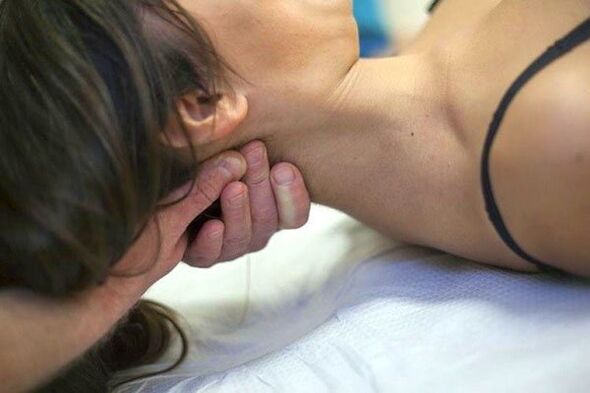Cervical osteochondrosis is a disease of the cervical spine in which joints and intervertebral discs are destroyed. The disease affects one-third of the world's population over the age of 35.
Cervical osteochondrosis suffers more than its counterparts in the lumbar, sacral, or thoracic region because it contains more nerve fibers.

Classification of features
The symptoms of this disease are associated with three main systems of the human body.
- The spinal cord is a violation of its integrity and compression.
- Peripheral nervous system - damage to its fibers.
- Vertebral artery is a disorder of blood flow and oxygen supply to the brain.
Disruption of these systems affects human health. The first symptoms are severe headaches.
Pain syndrome
Frequent headaches are the first signs of the disease. Sometimes the pain goes to the back of the head or shoulders. Unlike a common migraine, osteochondrosis of the cervical spine cannot be treated with painkillers alone. This problem requires complex treatment.
Lack of air
Symptoms of shortness of breath are often accompanied by cervical osteochondrosis. This is due to irritation of the phrenic nerve. A person suffering from a migraine of the cervical spine has difficulty breathing deeply, especially when it is difficult to breathe. At night, patients may have short breaks in breathing accompanied by snoring. If the patient's room is not ventilated, he develops hypoxia, which leads to impaired memory and concentration.
nausea
Symptoms of nausea are caused by a disease such as osteochondrosis of the lumbar spine due to impaired blood circulation in the brain. Sometimes symptoms of nausea are accompanied by vomiting, which can be seen when walking, turning and tilting the head. This is due to a lack of oxygen in the inner ear - where the center of balance is located.

Changes in blood pressure
A person diagnosed with cervical osteochondrosis must constantly tolerate fluctuations in blood pressure. Similar symptoms can occur with both hypertension and hypotension. This is due to poor oxygen supply to the vasomotor center located in the medulla oblongata.
Call and tinnitus
These symptoms are associated with damage to the inner ear, from which the vestibular apparatus is controlled. Sometimes there is a general hearing loss. Doctors call such symptoms cochlear syndrome.
fainting
Loss of consciousness or fainting are common symptoms in people suffering from a disease such as osteochondrosis of the cervical spine. The cause of this phenomenon is an open spasm of blood vessels caused by irritation of the curved bone processes of the vertebrae and nerve endings.
Pharyngeal symptoms
Similar symptoms manifest themselves as itching, dryness, or a feeling of a foreign body in the throat. This phenomenon is associated with a lesion of the spinal cord from the nerve trunks.
Decreased vision
The eyes also suffer from the appearance of a disease such as cervical lumbar osteochondrosis. Similar symptoms, such as decreased vision, occur due to damage to the spinal cord of neurovascular trunks.
Methods of treatment
So far, you can cure neck migraine in the following ways:
- drug treatment;
- physiotherapy treatment;
- treated with folk remedies.
Medical therapy
This treatment for cervical migraine involves the use of tablets and injections of analgesics. It is necessary to relieve pain in the neck, head and shoulders. Analgesic needles have the advantage of being fast.

In addition, injections and antispasmodic tablets should be used. These drugs are most effective in relieving spasms in the blood vessels of the spine.
Thus, antispasmodics protect the patient from fainting. In addition, antispasmodic injections are used to treat pregnant women. Because these needles are safe for mother and unborn child.
Treatment based on intravenous drugs is also effective.
They help restore blood circulation to the affected areas of the neck. These needles relieve pain and help partially relieve other symptoms.
Drug treatment based on the use of chondroprotectors is no less effective. These drugs prevent progressive osteochondrosis of the neck, restore cartilage tissue of the joints. The most effective drugs containing collagen hydrolyzate. Because this substance helps to regenerate cells destroyed by disease.
Physiotherapy
Currently, the treatment of osteochondrosis of the neck with the help of physiotherapeutic procedures is widely used. Most used:
- ultraviolet radiation (UVI);
- vibration effects;
- electrotherapy.
Ultraviolet treatment helps stop migraines in the neck due to the analgesic, bactericidal and anti-inflammatory effects of radiation. Ultraviolet radiation is used for migraines of the cervical spine behind the neck, in the subclavian region or in the upper part of the shoulder blades.
Exposure to vibration, as well as UVI, perfectly eliminates osteochondrosis of the cervical spine. Best of all, vibration relieves pain.

Electrotherapy treatment helps to get rid of pain, improve blood circulation and provide oxygen to brain cells. The most effective procedure is transcutaneous electrical neurostimulation.
Folk remedies
Since ancient times, grated potato and honey compresses have been used to treat neck migraines. Also an effective remedy for osteochondrosis of the neck was a mixture of radish juice, aloe and liquid honey.
Many healers have prepared an ointment based on hop cones and lard. However, the most effective folk remedy for a disease such as osteochondrosis of the neck is a decoction of thyme, chamomile, parsley, nettle and burdock.
These herbs are poured with boiling water and infused for 3 days in a dark place. Drink a tablespoon of this decoction twice a day.
Such an alternative treatment helps to cope with pain, improve blood circulation and saturate the brain with oxygen, which is very important for it.
































